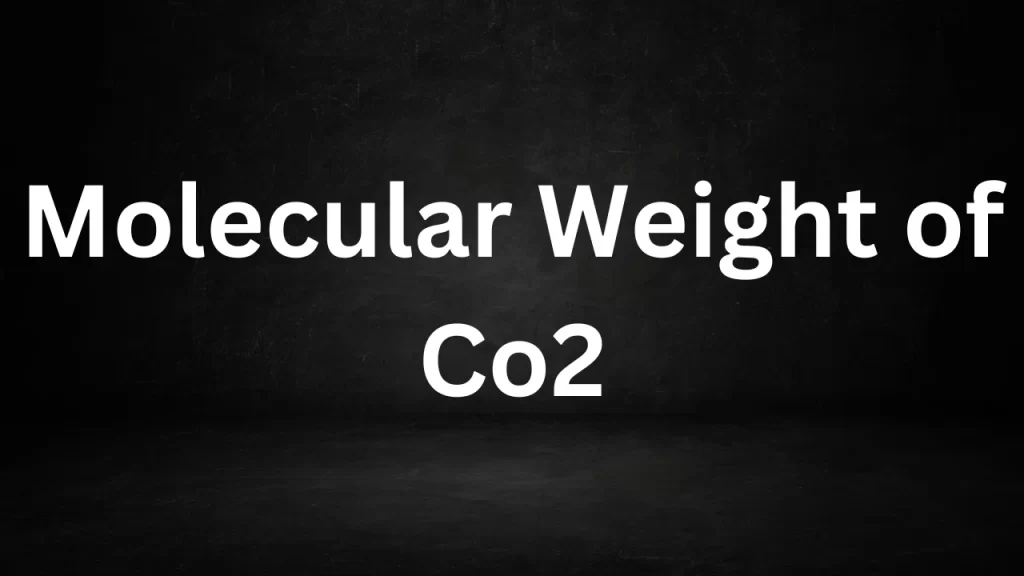Category: Class 9
Molecular Weight of Co2
Molecular Weight of Co2: Carbon dioxide (CO2) is a chemical compound that plays a significant role in various natural processes, climate change, and industrial applications.
Understanding its molecular weight is crucial in chemistry, environmental science, and engineering. In this article, we will explore the molecular weight of CO2, its composition, and its relevance in different fields.

mol Weight of Co2
mol Composition of CO2
Carbon dioxide (CO2) is composed of one carbon atom (C) and two oxygen atoms (O), bonded together through covalent bonds. Its chemical formula, CO2, reflects this composition, indicating one carbon atom and two oxygen atoms in a single molecule.
mol Weight of CO2
The mol weight of a substance is calculated by adding the atomic weights of all the atoms in its chemical formula. To determine the mol weight of CO2, we consider the atomic weights of carbon (C) and oxygen (O):
- The atomic weight of carbon (C) is approximately 12 atomic mass units (amu).
- The atomic weight of oxygen (O) is approximately 16 amu.
Now, let’s calculate the mol weight of CO2:
mol Weight of CO2 = (Atomic Weight of C) + 2 × (Atomic Weight of O) mol Weight of CO2 = 12 amu + 2 × 16 amu Molecular Weight of CO2 = 12 amu + 32 amu Molecular Weight of CO2 = 44 amu
Therefore, the mol weight of carbon dioxide (CO2) is 44 atomic mass units (amu).
Significance of the mol Weight of CO2
The mol weight of CO2 holds significant importance across various scientific disciplines:
1. Chemistry:
In chemistry, the mol weight of CO2 is essential for stoichiometry, which involves the calculation of reactant and product quantities in chemical reactions. It helps determine the balanced chemical equations and the molar relationships between substances in a reaction.
2. Environmental Science:
Understanding the mol weight of CO2 is vital in environmental science and climate change research. CO2 is a greenhouse gas, and its molecular weight influences its behavior in the atmosphere, including its role in trapping heat and contributing to global warming.
3. Industry and Engineering:
In industrial processes, the molecular weight of CO2 is relevant for designing equipment, such as compressors and separators, used in the extraction, storage, and transport of carbon dioxide. It is also crucial in carbon capture and storage (CCS) technologies.
4. Health and Safety:
In safety assessments and industrial hygiene, the molecular weight of CO2 is considered when evaluating its effects on human health. High concentrations of CO2 can be hazardous, affecting respiration and leading to asphyxiation.
5. Education and Research:
The mol weight of CO2 is a fundamental concept taught in chemistry and science education. It forms the basis for understanding chemical reactions, gas properties, and environmental issues.
Conclusion
The mol weight of carbon dioxide (CO2), calculated as 44 atomic mass units (amu), is a critical parameter with broad implications in chemistry, environmental science, industry, and safety. It governs the behavior of CO2 in various contexts, from chemical reactions to its role as a greenhouse gas. As we continue to grapple with climate change and environmental challenges, a deep understanding of CO2’s molecular weight remains indispensable in addressing these global issues.
Read More
- Molecular Mass of Water
- Difference Between Cyclone And Hurricane
- Molecular Weight Of Na
- Molecular Mass Of O2
- Molecular Mass of H2
Frequently Asked Questions (FAQs) Molecular Weight of Co2
Q1: What is the mol weight of CO2 (carbon dioxide)?
A1: The mol weight of carbon dioxide (CO2) is 44 atomic mass units (amu). This value is calculated by adding the atomic weights of one carbon atom (approximately 12 amu) and two oxygen atoms (approximately 16 amu each) in a CO2 molecule.
Q2: Why is knowing the mol weight of CO2 important?
A2: Understanding the mol weight of CO2 is important in various fields. In chemistry, it’s essential for stoichiometry and reaction calculations. In environmental science, it’s crucial for studying climate change and greenhouse gas emissions. It also has significance in industrial processes, safety assessments, and education.
Q3: How is the molecular weight of CO2 used in stoichiometry?
A3: In stoichiometry, the molecular weight of CO2 is used to calculate the molar relationships between substances in a chemical reaction. It helps determine the balanced chemical equations and allows for the calculation of reactant and product quantities.
Q4: What is the role of CO2’s mol weight in climate change research?
A4: CO2’s mol weight plays a role in climate change research because it influences how CO2 behaves in the atmosphere. CO2 is a greenhouse gas, and its molecular weight affects its ability to trap heat, contributing to global warming and climate change.
Q5: How is the mol weight of CO2 relevant in industry and engineering?
A5: In industry and engineering, the mol weight of CO2 is relevant for designing equipment used in processes involving CO2, such as compressors and separators. It’s also crucial in carbon capture and storage (CCS) technologies, which aim to mitigate CO2 emissions from industrial sources.
Molecular Mass of Water
Difference Between Cyclone And Hurricane
The Molecular Weight Of Na
Molecular Mass Of O2
Molecular Mass of H2
Molecular Mass of Water
Molecular Mass of Water: Water is a fundamental and ubiquitous substance in our world, covering about 71% of the Earth’s surface and making up a significant portion of living organisms.
At a molecular level, water consists of two hydrogen atoms and one oxygen atom bonded together, represented as H2O. In this article, we will explore the molecular mass of water and its significance in chemistry and everyday life.
Molecular Mass of Water
Molecular Composition of Water
Water’s molecular formula, H2O, describes the specific arrangement of its atoms. In a water molecule, two hydrogen atoms (H) are covalently bonded to one oxygen atom (O). This simple structure belies the remarkable properties and importance of water in various natural and chemical processes.
Molecular Mass of Water
The molecular mass of a substance is the sum of the atomic masses of all the atoms in a molecule. To calculate the molecular mass of water (H2O), we add the atomic masses of its constituent elements:
- The atomic mass of hydrogen (H) is approximately 1 atomic mass unit (amu).
- The atomic mass of oxygen (O) is approximately 16 amu.
Therefore, the molecular mass of water is:
Molecular mass of H2O = (2 × Atomic mass of H) + Atomic mass of O Molecular mass of H2O = (2 × 1 amu) + 16 amu Molecular mass of H2O = 2 amu + 16 amu Molecular mass of H2O = 18 amu
The molecular mass of water is 18 atomic mass units (amu).
Significance of the Molecular Mass of Water
The molecular mass of water is a critical concept in chemistry and has several significant implications:
1. Stoichiometry:
In chemical reactions, the molecular mass of water is essential for stoichiometric calculations. It helps determine the quantities of reactants and products involved in a chemical reaction. As an illustration, in the reaction where hydrogen gas (H2) combines with oxygen gas (O2) to produce water (H2O), the mol. mass of water is employed to determine the stoichiometry of the reaction.
2. Concentrations and Solutions:
The molecular mass of water is employed for the computation of substance concentrations within solutions. The concept of molarity (moles of solute per liter of solution) relies on knowing the mol. mass of solutes, including water itself when it acts as a solvent.
3. Physical Properties:
Water’s mol mass contributes to its unique physical properties, such as its high boiling point, melting point, and heat capacity. These properties are essential for life and various industrial processes.
4. Environmental Science:
Understanding the mol mass of water is crucial in environmental science and ecology. It plays a role in the study of water pollution, the water cycle, and the behavior of substances dissolved in water bodies.
5. Health and Nutrition:
The mol mass of water is also relevant in health and nutrition. It is used to calculate the molecular mass of nutrients and substances in food and beverages, aiding in dietary planning and analysis.
6. Laboratory Techniques:
In laboratories, chemists use the mol mass of water to calibrate instruments, prepare solutions of known concentrations, and analyze samples using techniques like mass spectrometry and chromatography.
Conclusion
The mol mass of water, represented as H2O, is a fundamental concept in chemistry and plays a vital role in various scientific, industrial, and everyday applications. It not only defines the composition of water but also influences its physical and chemical properties. Understanding the mol mass of water is essential for stoichiometry, concentration calculations, environmental studies, and numerous other fields, underlining its significance in our understanding of the natural world and the chemical processes that govern it.
Read More
- Difference Between Cyclone And Hurricane
- Molecular Weight Of Na
- Molecular Mass Of O2
- Molecular Mass of H2
- Molecular Mass Of NH3
Frequently Asked Questions (FAQs) Mol Mass of Water
Q1: What is the mol mass of water (H2O)?
The mol mass of water (H2O) is 18 atomic mass units (amu). The determination of this value involves summing the atomic masses of two hydrogen atoms (each roughly 1 amu) and one oxygen atom (approximately 16 amu) within a water molecule.
Q2: Why is the mol mass of water important in chemistry?
The mol mass of water holds significant importance in chemistry as it plays a pivotal role in stoichiometry, where it helps ascertain the amounts of substances involved in chemical reactions, both as reactants and products. It is also essential for calculating concentrations in solutions and plays a role in understanding the physical and chemical properties of water.
Q3: How is the molecular mass of water relevant in everyday life?
The mol. mass of water is relevant in everyday life in various ways. It contributes to the unique physical properties of water, such as its high boiling and melting points, which are essential for cooking and various industrial processes. Additionally, it is important in health and nutrition for calculating nutrient content in foods and beverages.
Q4: Is the molecular mass of water used in environmental science?
Certainly, the molecular mass of water finds application in the field of environmental science. It is relevant in studies of water pollution, the water cycle, and the behavior of substances dissolved in water bodies. Understanding water’s molecular mass is crucial for assessing its impact on the environment.
Q5: How is the molecular mass of water determined experimentally?
The molecular mass of water can be determined experimentally using various analytical techniques, including mass spectrometry and chromatography. These methods involve measuring the mass-to-charge ratios of H2O molecules and their fragments, allowing for precise determination of molecular mass.
Difference Between Cyclone And Hurricane
Difference Between Cyclone And Hurricane: Cyclones and hurricanes are both powerful weather phenomena known for their destructive potential, but they are given different names based on their location and characteristics.
These storms are essentially the same natural disasters, but they are called by different names in different parts of the world. In this article, we will explore the key differences between cyclones and hurricanes.

Difference Between Cyclone And Hurricane
Cyclone:
1. Geographic Location:
- Cyclones are tropical storms that occur in the Indian Ocean and the South Pacific Ocean.
- In the South Pacific, they are known as cyclones.
- In the Indian Ocean, they are referred to as cyclones as well.
2. Nomenclature:
- Cyclones are typically named by the meteorological agencies of the countries affected by them.
- Names are assigned alphabetically, often based on a predetermined list of names for the region.
3. Wind Direction:
- In the Southern Hemisphere, cyclones rotate counterclockwise (anticlockwise).
- In the Northern Hemisphere, they rotate clockwise.
4. Notable Cyclones:
- Some notable cyclones include Cyclone Tracy, which devastated Darwin, Australia in 1974, and Cyclone Phailin, which hit the eastern coast of India in 2013.
Hurricane:
1. Geographic Location:
- Hurricanes occur in the Atlantic Ocean and the northeastern Pacific Ocean.
- In the Atlantic, they are known as hurricanes.
- In the northeastern Pacific, they are referred to as hurricanes as well.
2. Nomenclature:
- Hurricanes are named according to a predetermined list of names established by the World Meteorological Organization (WMO).
- Names are assigned alphabetically and alternate between male and female names.
3. Wind Direction:
- In the Northern Hemisphere, hurricanes rotate counterclockwise.
- In the Southern Hemisphere, hurricanes rotate clockwise.
4. Notable Hurricanes:
- Some famous hurricanes include Hurricane Katrina, which struck the Gulf Coast of the United States in 2005, and Hurricane Maria, which devastated Puerto Rico in 2017.
Similarities:
- While cyclones and hurricanes have distinct names and are found in different ocean basins, they share several common characteristics:
- Formation: Both cyclones and hurricanes originate as tropical storms over warm ocean waters, where they gain energy from the heat and moisture in the atmosphere.
- Destructive Potential: Both can intensify into extremely powerful and destructive storms, with high winds, heavy rainfall, and the potential for storm surges that can lead to coastal flooding.
- Tracking and Prediction: Meteorological agencies closely monitor the development and path of both cyclones and hurricanes, providing advance warning to potentially affected regions.
In conclusion, the main difference between cyclones and hurricanes lies in their geographic locations and the names used to refer to them in different parts of the world. Despite these variations, they share common characteristics and pose similar threats to coastal areas and communities, emphasizing the importance of preparedness and effective disaster response.
Read More
- Molecular Weight Of Na
- Molecular Mass Of O2
- Molecular Mass of H2
- Molecular Mass Of NH3
- Molecular Mass Of Ch4
Frequently Asked Questions (FAQs) Difference Between Cyclone And Hurricane
Q1: What is the primary difference between a cyclone and a hurricane?
A1: The primary difference between a cyclone and a hurricane is their geographic location and the terminology used to describe them. Cyclones are tropical storms that occur in the Indian Ocean and the South Pacific, while hurricanes are tropical storms that occur in the Atlantic Ocean and the northeastern Pacific. They are essentially the same meteorological phenomenon but are given different names based on their location.
Q2: How do the names of cyclones and hurricanes differ?
A2: Cyclones are typically named by the meteorological agencies of the countries affected by them, and names are often assigned alphabetically from predetermined lists for their respective regions. In contrast, hurricanes are named according to a predetermined list established by the World Meteorological Organization (WMO). The names for hurricanes are chosen internationally and alternate between male and female names.
Q3: Do cyclones and hurricanes rotate in the same direction?
A3: No, the direction of rotation of cyclones and hurricanes depends on their hemisphere. In the Northern Hemisphere, both cyclones and hurricanes rotate counterclockwise. In the Southern Hemisphere, they rotate clockwise. This is due to the Coriolis effect, caused by the Earth’s rotation, which influences the direction of motion in large-scale weather systems.
Q4: Are cyclones and hurricanes equally destructive?
A4: Both cyclones and hurricanes have the potential to be extremely destructive, with high winds, heavy rainfall, and the potential for storm surges that can lead to coastal flooding. The level of destruction depends on factors such as the storm’s intensity, size, and the vulnerability of the affected areas.
Q5: Can a cyclone turn into a hurricane or vice versa?
A5: Cyclones and hurricanes are essentially the same meteorological phenomenon, but they are given different names based on their location. While they can have similar characteristics, they do not spontaneously change from one to the other. They maintain their names and characteristics based on the ocean basin in which they form.
Molecular Weight Of Na
Molecular Weight Of Na: Sodium, with the chemical symbol Na and atomic number 11, is an essential element found in the Earth’s crust and oceans.
In this article, we will explore the molecular weight of sodium, its significance in chemistry, and its critical role in various biological and chemical processes.

Molecular Weight Of Na
The Ubiquitous Element: Sodium
Sodium is one of the most abundant elements on Earth, primarily occurring in the form of compounds like sodium chloride (table salt) and various minerals. It is a highly reactive metal that is never found in its pure form in nature due to its extreme reactivity with moisture and oxygen.
Molecular Weight of Sodium (Na)
The molecular weight of an element, often referred to as its atomic weight or molar mass, is defined as the mass of one mole of atoms of that element, measured in grams per mole (g/mol). To calculate the molecular weight of sodium (Na), we use its atomic mass:
- Sodium (Na) has an atomic mass of approximately 22.99 g/mol.
- The molecular weight of sodium is, therefore, approximately 22.99 grams per mole.
Significance of Molecular Weight in Chemistry
The molecular weight of sodium is a fundamental value in chemistry. It is used in stoichiometry, chemical calculations, and the formulation of chemical equations. Chemists rely on molecular weights to determine the quantity of sodium and other elements involved in chemical reactions, allowing for precise measurements and accurate predictions.
Sodium’s Role in Biology and Chemistry
Sodium plays pivotal roles in both biology and chemistry:
1. Biological Significance: Sodium is an essential electrolyte in the human body, critical for various physiological processes. It including nerve function, muscle contraction, and maintaining fluid balance. Sodium ions (Na+) are actively transported in and out of cells, contributing to electrical impulses and the transmission of signals in the nervous system.
2. Chemical Reactivity: Sodium is highly reactive, particularly in the presence of water. It vigorously reacts with water to produce sodium hydroxide (NaOH) and hydrogen gas (H2). This property makes sodium valuable in various chemical processes and industries.
3. Sodium Compounds: Sodium forms compounds with a wide range of elements, such as chlorine (NaCl), forming common table salt. These compounds have diverse applications in food, industry, and medicine.
Conclusion
The molecular weight of sodium (Na), approximately 22.99 g/mol, represents the mass of one mole of sodium atoms. This seemingly simple element is indispensable in the natural world, influencing both biological and chemical processes. Sodium’s importance in maintaining human health, its reactivity in chemical reactions. Its role in various compounds underscore its significance in our daily lives and in the broader fields of chemistry and biology.
Read More
- Molecular Mass Of O2
- Molecular Mass of H2
- Molecular Mass Of NH3
- Molecular Mass Of Ch4
- Nitric Acid Molar Mass
Frequently Asked Questions (FAQs) Molecular Weight Of Na
Q1: What is the molecular weight of sodium (Na)?
A1: The molecular weight of sodium (Na) is approximately 22.99 grams per mole (g/mol).
Q2: Why is the molecular weight of sodium important in chemistry?
A2: The molecular weight of sodium is important because it allows chemists to determine the mass of one mole of sodium atoms. Which is crucial for stoichiometry, chemical calculations, and the formulation of chemical reactions. It helps in understanding the quantity of sodium involved in various chemical processes.
Q3: Is sodium always found in compounds rather than in its pure form in nature?
A3: Yes, sodium is highly reactive with moisture and oxygen, so it is never found in its pure form in nature. Instead, it is typically found in the form of compounds, such as sodium chloride (table salt), sodium carbonate, and various minerals.
Q4: What is the significance of sodium in biology?
A4: Sodium is an essential element in biology, playing a crucial role in nerve function, muscle contraction, and maintaining fluid balance in the human body. Sodium ions (Na+) are involved in transmitting electrical signals in the nervous system.
Q5: How is sodium used in chemistry and industry?
A5: Sodium’s reactivity makes it valuable in various chemical processes and industries. It is used in the production of sodium hydroxide (NaOH), which is a key ingredient in the manufacture of soap, paper, and textiles. Sodium also has applications in metallurgy, organic synthesis, and as a reducing agent in some chemical reactions.
Molecular Mass Of O2
Molecular Mass Of O2: Oxygen, an essential element for life as we know it, exists primarily in the form of a diatomic molecule, O2, known as oxygen gas. In this article, we will explore the molecular mass of oxygen gas (O2), its significance in chemistry and biology, and its vital role in supporting life on Earth.

Molecular Mass Of O2
The Life-Sustaining Element: Oxygen
Oxygen, with the chemical symbol O and atomic number 8, is the third-most abundant element in the universe and the most abundant element in the Earth’s crust. It is a critical component of the Earth’s atmosphere, making up approximately 21% of the air we breathe. Oxygen is essential for respiration in most living organisms, serving as a key player in the processes that produce energy from food.
Molecular Structure of Oxygen Gas
Before discussing the molecular mass of oxygen gas, it’s important to understand its molecular structure. Oxygen gas consists of two oxygen (O) atoms bonded together, forming a diatomic molecule, O2. This diatomic molecule is the most common form of molecular oxygen found in the Earth’s atmosphere.
Molecular Mass of Oxygen Gas (O2)
The molecular mass of a compound, often referred to as its molar mass, is defined as the mass of one mole of molecules of that compound, measured in grams per mole (g/mol). To calculate the molecular mass of oxygen gas (O2), we sum the atomic masses of its constituent atoms:
- Oxygen (O) has an atomic mass of approximately 16.00 g/mol.
- Now, let’s calculate the molecular mass of oxygen gas:
- Molecular Mass of Oxygen Gas (O2) = (2 × Atomic Mass of Oxygen)
- Molecular Mass of Oxygen Gas (O2) = (2 × 16.00 g/mol)
- Molecular Mass of Oxygen Gas (O2) ≈ 32.00 g/mol
- So, the molecular mass of oxygen gas is approximately 32.00 grams per mole.
Significance of Molecular Mass in Chemistry and Biology
The molecular mass of oxygen gas is a fundamental value in both chemistry and biology. In chemistry, it is used for stoichiometry, chemical calculations, and the formulation of chemical equations. In biology, understanding the molecular mass of oxygen gas is crucial for comprehending the processes of respiration, where oxygen is used by cells to generate energy.
Conclusion
The molecular mass of oxygen gas (O2), approximately 32.00 g/mol, underscores the importance of this diatomic molecule in supporting life on Earth. From the air we breathe to the energy-producing reactions occurring within our cells, oxygen gas plays a central role in the biology and chemistry of our planet. Its molecular mass serves as a foundation for understanding the processes that sustain life and drive chemical reactions in the natural world.
Read More
- Molecular Mass of H2
- Molecular Mass Of NH3
- Molecular Mass Of Ch4
- Nitric Acid Molar Mass
- Molar Mass of Helium
Frequently Asked Questions (FAQs) Molecular Mass Of O2
Q1: What is the molecular mass of O2 (oxygen gas)?
A1: The molecular mass of O2 (oxygen gas) is approximately 32.00 grams per mole (g/mol).
Q2: Why is the molecular mass of oxygen gas important in chemistry and biology?
A2: The molecular mass of oxygen gas is important because it allows chemists to determine the mass of one mole of oxygen gas molecules, which is essential for stoichiometry, chemical calculations, and the formulation of chemical reactions. In biology, it is crucial for understanding processes like respiration, where oxygen is used by living organisms to generate energy.
Q3: Is oxygen gas the only form of oxygen in the Earth’s atmosphere?
A3: No, oxygen gas (O2) is the most abundant form of oxygen in the Earth’s atmosphere, making up about 21% of the air we breathe. However, there is also a trace amount of another form, ozone (O3), which is found in the ozone layer in the upper atmosphere and plays a critical role in protecting life on Earth from harmful ultraviolet (UV) radiation.
Q4: How is oxygen gas produced for industrial and medical purposes?
A4: Oxygen gas for industrial and medical purposes is often produced through processes such as fractional distillation of air or by electrolysis of water. In fractional distillation, air is cooled and compressed to separate its components, with oxygen being one of the products. Electrolysis of water involves passing an electric current through water to split it into hydrogen and oxygen gases.
Q5: What happens when oxygen gas is inhaled by living organisms?
A5: When oxygen gas is inhaled, it is transported by the circulatory system to cells throughout the body. Inside cells, oxygen is used in metabolic processes, particularly in the mitochondria, to generate energy through aerobic respiration. The waste product of this process is carbon dioxide (CO2), which is then expelled from the body when we exhale.
Molecular Mass of H2
Molecular Mass of H2: Hydrogen, the lightest and most abundant element in the universe, plays a pivotal role in both chemistry and astrophysics. In this article, we will explore the molecular mass of hydrogen gas (H2), its significance in science, and its widespread applications.

Molecular Mass of H2
The Remarkable Element Hydrogen
Hydrogen, with the chemical symbol H and atomic number 1, is the simplest and most fundamental element. It is found in great abundance throughout the universe, making up roughly 75% of its elemental mass. In its pure molecular form, hydrogen exists as a diatomic gas, H2, which is colorless, odorless, and highly flammable.
Molecular Structure of Hydrogen Gas
Before diving into the molecular mass of hydrogen gas, it’s essential to understand its molecular structure. Hydrogen gas consists of two hydrogen (H) atoms covalently bonded together. This diatomic molecule is the most straightforward form of hydrogen, and it serves as a basic building block in the formation of more complex compounds.
Molecular Mass of Hydrogen Gas (H2)
The molecular mass of a compound, often referred to as its molar mass, is defined as the mass of one mole of molecules of that compound, measured in grams per mole (g/mol). To calculate the molecular mass of hydrogen gas (H2), we sum the atomic masses of its constituent atoms:
- Hydrogen (H) has an atomic mass of approximately 1.01 g/mol.
Now, let’s calculate the molecular mass of hydrogen gas:
Molecular Mass of Hydrogen Gas (H2) = (2 × Atomic Mass of Hydrogen)
Molecular Mass of Hydrogen Gas (H2) = (2 × 1.01 g/mol)
Molecular Mass of Hydrogen Gas (H2) ≈ 2.02 g/mol
So, the molecular mass of hydrogen gas is approximately 2.02 grams per mole.
Significance of Molecular Mass in Chemistry
The molecular mass of hydrogen gas is a fundamental value in chemistry. It serves as a reference point for determining the masses of molecules and compounds that contain hydrogen. Chemists use this value extensively in stoichiometry, chemical calculations, and the formulation of chemical equations. Understanding the molecular mass of hydrogen gas is vital for precise measurements and calculations in various chemical processes.
Conclusion
The molecular mass of hydrogen gas (H2), approximately 2.02 g/mol, represents one of the lightest molecules in the universe. Despite its simplicity, hydrogen plays a central role in both scientific research and technological applications, from its use as a fuel in clean energy technologies to its presence in the stars and galaxies that fill our night skies. Understanding the molecular mass of hydrogen gas is a foundational step in appreciating its significance in the natural world and its potential for powering our future.
Read More
- Molecular Mass Of NH3
- Molecular Mass Of Ch4
- Nitric Acid Molar Mass
- Molar Mass of Helium
- Molecular Mass of CH3COOH
Frequently Asked Questions (FAQs) Molecular Mass of H2
Q1: What is the molecular mass of H2 (hydrogen gas)?
A1: The molecular mass of H2 (hydrogen gas) is approximately 2.02 grams per mole (g/mol).
Q2: Why is the molecular mass of hydrogen gas important in chemistry and physics?
A2: The molecular mass of hydrogen gas is crucial because it serves as a reference for determining the masses of molecules and compounds containing hydrogen. It is fundamental in stoichiometry, chemical calculations, and the formulation of chemical reactions. In physics, it is essential for understanding the behavior of hydrogen in astrophysical and laboratory settings.
Q3: Is hydrogen gas the lightest element in the periodic table?
A3: Yes, hydrogen is the lightest element in the periodic table. It has the lowest atomic number (1) and the lightest atomic mass among all elements.
Q4: Can hydrogen gas be used as a fuel source?
A4: Yes, hydrogen gas is considered a clean and efficient fuel source. When it undergoes combustion or reacts in fuel cells, it produces energy with water (H2O) as the only byproduct, making it an attractive option for clean energy technologies.
Q5: What are some common applications of hydrogen gas in industry and research?
A5: Hydrogen gas has various applications, including:
- Clean energy: It can be used as a fuel in fuel cells to generate electricity.
- Industrial processes: Hydrogen is used in the production of ammonia (NH3) and methanol (CH3OH), among other chemicals.
- Metal processing: It is employed in reducing metal ores and refining metals.
- Astrophysics: Hydrogen plays a fundamental role in the composition of stars and galaxies.
Molecular Mass Of NH3
Molecular Mass Of NH3: Ammonia, with the chemical formula NH3, is a compound that finds applications in various fields, from household cleaning products to industrial processes. In this article, we will delve into the molecular mass of ammonia and its significance in chemistry and everyday life.

Molecular Mass Of NH3
The Versatility of Ammonia
Ammonia is a colorless, pungent gas with a distinctive odor. It is highly soluble in water, making it a useful compound in a wide range of applications. Ammonia is commonly used in household cleaning products, refrigeration systems, and as a crucial component in the production of fertilizers. It also serves as a refrigerant in some industrial processes.
Molecular Structure of Ammonia
Before we discuss the molecular mass of ammonia, let’s examine its molecular structure. Ammonia consists of one nitrogen (N) atom bonded to three hydrogen (H) atoms. The arrangement of these atoms results in a pyramid-like shape, with the nitrogen atom at the apex and the three hydrogen atoms forming the base.
Molecular Mass of Ammonia (NH3)
The molecular mass of a compound, often referred to as its molar mass, is defined as the mass of one mole of molecules of that compound, measured in grams per mole (g/mol). To calculate the molecular mass of ammonia (NH3), we sum the atomic masses of its constituent atoms:
- Nitrogen (N) has an atomic mass of approximately 14.01 g/mol.
- Hydrogen (H) has an atomic mass of approximately 1.01 g/mol.
Now, let’s calculate the molecular mass of ammonia:
Molecular Mass of Ammonia (NH3) = (1 × Atomic Mass of Nitrogen) + (3 × Atomic Mass of Hydrogen)
Molecular Mass of Ammonia (NH3) = (1 × 14.01 g/mol) + (3 × 1.01 g/mol)
Molecular Mass of Ammonia (NH3) ≈ 17.04 g/mol
So, the molecular mass of ammonia is approximately 17.04 grams per mole.
Significance of Molecular Mass in Chemistry
The molecular mass of ammonia is a crucial value in chemistry. It serves as a reference point for determining the masses of molecules and compounds that contain ammonia. Chemists use this value extensively in stoichiometry, chemical calculations, and the formulation of chemical equations. It helps determine the quantity of ammonia involved in chemical reactions, allowing for precise measurements and accurate predictions.
Conclusion
The molecular mass of ammonia (NH3), approximately 17.04 g/mol, is a fundamental parameter in the world of chemistry and science. It underlines the significance of this versatile compound in various applications, from household chores to agriculture and industry. Whether you’re cleaning your windows or contributing to the global food supply through fertilizer production, understanding the molecular mass of ammonia is essential for ensuring the effectiveness and safety of these processes.
Read More
- Molecular Mass Of Ch4
- Nitric Acid Molar Mass
- Molar Mass of Helium
- Molecular Mass of CH3COOH
- Molecular Weight of kmno4
Frequently Asked Questions (FAQs) Molecular Mass Of NH3
Q1: What is the molecular mass of NH3 (ammonia)?
A1: The molecular mass of NH3 (ammonia) is approximately 17.04 grams per mole (g/mol).
Q2: Why is the molecular mass of ammonia important in chemistry?
A2: The molecular mass of ammonia is important because it allows chemists to determine the mass of one mole of ammonia molecules, which is crucial for stoichiometry, chemical calculations, and the formulation of chemical reactions. It helps in understanding the quantity of ammonia involved in various chemical processes.
Q3: What are the main applications of ammonia in everyday life and industry?
A3: Ammonia has several applications, including:
- Household cleaning: Ammonia is used in various cleaning products for windows, floors, and surfaces.
- Refrigeration: It serves as a refrigerant in some refrigeration systems.
- Fertilizer production: Ammonia is a key component in the manufacturing of nitrogen-based fertilizers used in agriculture.
- Chemical manufacturing: It is used as a raw material in the production of various chemicals and compounds.
- Environmental control: Ammonia is used to control emissions in industrial processes and power plants.
Q4: Is ammonia safe to handle, or are there any safety considerations?
A4: Ammonia can be hazardous due to its pungent odor and its potential to release toxic fumes. When handling ammonia, it is essential to follow safety guidelines, wear appropriate protective gear, and ensure proper ventilation. Inhaling concentrated ammonia vapors can be harmful to health.
Q5: Can ammonia be synthesized or produced in a laboratory setting?
A5: Yes, ammonia can be synthesized in a laboratory setting through various methods, including the Haber-Bosch process, which is a widely used industrial method for ammonia production. In this process, nitrogen gas (N2) and hydrogen gas (H2) are combined under high temperature and pressure in the presence of a catalyst to produce ammonia.
Molecular Mass Of Ch4
Molecular Mass Of Ch4: Methane (CH4) is the simplest hydrocarbon, consisting of one carbon atom bonded to four hydrogen atoms. In this article, we will explore the molecular mass of methane and its significance in chemistry and various applications.
Molecular Mass Of Ch4
The Role of Methane
Methane, often called “natural gas” when it’s in its gaseous state, plays a crucial role in both nature and industry. It is a potent greenhouse gas and a primary component of the Earth’s atmosphere. Methane also serves as a valuable energy resource when extracted and used for heating, electricity generation, and as a fuel for vehicles.
Molecular Structure of Methane
Before we delve into the molecular mass of methane, let’s examine its molecular structure. Methane consists of a single carbon (C) atom bonded to four hydrogen (H) atoms, forming a tetrahedral arrangement. This simple, symmetrical structure is the foundation of the hydrocarbon family and showcases the versatile nature of carbon in forming covalent bonds.
Molecular Mass of Methane (CH4)
The molecular mass of a compound, also known as its molar mass, is defined as the mass of one mole of molecules of that compound, expressed in grams per mole (g/mol). To calculate the molecular mass of methane (CH4), we sum the atomic masses of its constituent atoms:
- Carbon (C) has an atomic mass of approximately 12.01 g/mol.
- Hydrogen (H) has an atomic mass of approximately 1.01 g/mol.
Now, let’s calculate the molecular mass of methane:
Molecular Mass of Methane (CH4) = (1 × Atomic Mass of Carbon) + (4 × Atomic Mass of Hydrogen)
Molecular Mass of Methane (CH4) = (1 × 12.01 g/mol) + (4 × 1.01 g/mol)
Molecular Mass of Methane (CH4) ≈ 16.05 g/mol
So, the molecular mass of methane is approximately 16.05 grams per mole.
Significance of Molecular Mass in Chemistry
The molecular mass of methane is a fundamental value in chemistry. It is used in stoichiometry, chemical calculations, and the formulation of chemical equations. This value helps chemists determine the quantity of methane involved in chemical reactions, allowing for precise measurements and the ability to predict reaction outcomes.
Conclusion
The molecular mass of methane (CH4), approximately 16.05 g/mol, is a crucial piece of information for chemists, scientists, and engineers. It highlights the fundamental nature of this simple hydrocarbon, which not only plays a significant role in our environment but also serves as an essential resource in various industrial and energy applications. Understanding the molecular mass of methane is the first step in appreciating its importance in both the natural world and our technological advancements.
Read More
- Nitric Acid Molar Mass
- Molar Mass of Helium
- Molecular Mass of CH3COOH
- Molecular Weight of kmno4
- Molecular Weight of CaCO3
Frequently Asked Questions (FAQs) Molecular Mass Of Ch4
Q1: What is the molecular mass of CH4 (methane)?
A1: The molecular mass of CH4 (methane) is approximately 16.05 grams per mole (g/mol).
Q2: Why is the molecular mass of methane important in chemistry?
A2: The molecular mass of methane is important because it allows chemists to determine the mass of one mole of methane molecules, which is crucial for stoichiometry, chemical calculations, and the formulation of chemical reactions. It helps in understanding the quantity of methane involved in chemical processes.
Q3: What is the molecular structure of methane?
A3: Methane (CH4) has a tetrahedral molecular structure consisting of one carbon (C) atom bonded to four hydrogen (H) atoms. This simple and symmetrical structure is a fundamental representation of hydrocarbons.
Q4: Is methane a natural gas, and how is it used in industry and daily life?
A4: Yes, methane is often referred to as natural gas when it occurs in its gaseous state. It is used for various purposes, including heating homes and buildings, generating electricity, and as a fuel for vehicles. In industry, methane serves as a raw material for the production of chemicals and plastics.
Q5: Is methane a greenhouse gas, and what are its environmental implications?
A5: Yes, methane is a potent greenhouse gas. Its presence in the atmosphere contributes to global warming and climate change. Methane emissions primarily come from natural sources like wetlands and human activities such as the production and transport of fossil fuels, agriculture, and waste management. Reducing methane emissions is a critical step in mitigating climate change.
Nitric Acid Molar Mass
Nitric Acid Molar Mass: Nitric acid (HNO3) is a powerful and versatile chemical with a wide range of applications in industry, chemistry, and even explosives manufacturing. In this article, we will explore the molar mass of nitric acid, its molecular structure, and its significance in various chemical processes.

Nitric Acid Molar Mass
The Importance of Nitric Acid
Nitric acid, sometimes simply referred to as “nitrate,” is a highly corrosive and strong acid. It is a crucial reagent in many chemical reactions, including the production of fertilizers, explosives, dyes, and various other chemicals. Additionally, it is used in the etching of metals, pickling of stainless steel, and in the manufacturing of nitrate salts, which have applications in food preservation.
Molecular Structure of Nitric Acid
Before delving into the molar mass of nitric acid, let’s understand its molecular structure. Nitric acid has a simple yet distinctive chemical formula: HNO3. This formula represents one hydrogen (H) atom, one nitrogen (N) atom, and three oxygen (O) atoms bonded together.
In its molecular structure, the nitrogen atom is bonded to one oxygen atom through a single bond and to another oxygen atom through a double bond. The third oxygen atom is connected to the nitrogen atom via a single bond and also bonded to one of the other oxygen atoms through a double bond. The presence of these double bonds and the arrangement of atoms give nitric acid its unique properties.
Molar Mass of Nitric Acid
The molar mass of a compound is defined as the mass of one mole of molecules of that compound, measured in grams per mole (g/mol). To calculate the molar mass of nitric acid (HNO3), we sum the atomic masses of its constituent atoms:
- Hydrogen (H) has an atomic mass of approximately 1.01 g/mol.
- Nitrogen (N) has an atomic mass of approximately 14.01 g/mol.
- Oxygen (O) has an atomic mass of approximately 16.00 g/mol.
Now, let’s calculate the molar mass of nitric acid:
Mol Mass of Nitric Acid (HNO3) = (1 × Atomic Mass of Hydrogen) + (1 × Atomic Mass of Nitrogen) + (3 × Atomic Mass of Oxygen)
Molar Mass of Nitric Acid (HNO3) ≈ (1 × 1.01 g/mol) + (1 × 14.01 g/mol) + (3 × 16.00 g/mol)
Molar Mass of Nitric Acid (HNO3) ≈ 63.03 g/mol
So, the molar mass of nitric acid is approximately 63.03 grams per mole.
Significance of Molar Mass in Chemistry
The mol mass of nitric acid is a crucial value in chemistry. It allows chemists to determine the quantity of nitric acid needed for specific chemical reactions and ensures precise measurements when handling this powerful acid. Whether it’s in the production of fertilizers to enhance crop growth or in the synthesis of explosives, a clear understanding of nitric acid’s molar mass is essential for safe and effective chemical processes.
Conclusion
The mol mass of nitric acid, approximately 63.03 g/mol, is a fundamental parameter in the world of chemistry. It underlines the importance of this potent acid in various industrial processes and scientific applications, emphasizing the need for careful handling and precise measurements to harness its powerful reactivity safely and effectively.
Read More
- Molar Mass of Helium
- Molecular Mass of CH3COOH
- Molecular Weight of kmno4
- Molecular Weight of CaCO3
- Molecular Mass Of CaCO3
Frequently Asked Questions (FAQs) Nitric Acid Molar Mass
Q1: What is the mol mass of nitric acid?
A1: The mol mass of nitric acid (HNO3) is approximately 63.03 grams per mole (g/mol).
Q2: Why is the mol mass of nitric acid important in chemistry?
A2: The mol mass of nitric acid is crucial because it allows chemists to relate the mass of nitric acid molecules to the number of molecules present in a sample. This value is fundamental for stoichiometry, chemical calculations, and the formulation of chemical reactions, especially when working with nitric acid in various industrial processes.
Q3: What are the main applications of nitric acid in industry and chemistry?
A3: Nitric acid is used in various applications, including:
- Fertilizer production: It’s a key component in the manufacturing of ammonium nitrate, a common nitrogen fertilizer.
- Explosives production: Nitric acid is used in the synthesis of explosives like nitroglycerin and TNT.
- Dye production: It’s used in the production of dyes and pigments.
- Metals processing: Nitric acid is employed in metal etching, cleaning, and pickling.
- Food preservation: In the form of nitrate salts, it’s used for curing and preserving meats.
Q4: Is nitric acid a strong acid?
A4: Yes, nitric acid is considered a strong acid. It readily donates a hydrogen ion (H+) in aqueous solution, making it highly acidic and capable of reacting vigorously with other substances.
Q5: Can nitric acid be dangerous to handle due to its strength and corrosiveness?
A5: Yes, nitric acid is highly corrosive and can be dangerous to handle. It can cause severe burns, and its fumes can be harmful if inhaled. Proper safety precautions, including the use of appropriate protective equipment and careful handling, are essential when working with nitric acid.
Molar Mass of Helium
Molar Mass of Helium: Helium, symbolized as He on the periodic table, is the second most abundant element in the universe, following hydrogen. It is renowned for its lightness, its ability to make balloons float, and its critical role in various scientific and industrial applications.
One essential aspect of helium is its molar mass, a fundamental concept in chemistry. In this article, we explore the molar mass of helium, its significance, and how it is calculated.
Molar Mass of Helium
Table of Contents:
Introduction to Helium
- Helium’s Discovery and Occurrence
- Unique Properties of Helium
What is Molar Mass?
- Definition and Significance
- The Concept of Mole in Chemistry
Calculating the Molar Mass of Helium
- Atomic Mass Units (amu)
- Molar Mass Calculation
The Significance of Helium’s Low Molar Mass
- Lightness and Buoyancy
- Helium in Balloons and Airships
Helium in Scientific and Industrial Applications
- Cryogenics and Superconductivity
- Welding and Leak Detection
- Medical Applications
Conclusion
- The Light but Essential Element
Introduction to Helium
Helium’s Discovery and Occurrence: Helium was first discovered in 1868 by French astronomer Pierre Janssen during a solar eclipse. It was subsequently identified on Earth in natural gas fields. Today, helium is primarily extracted from natural gas reservoirs, particularly in the United States.
Unique Properties of Helium: Helium possesses several unique properties, including being colorless, odorless, and tasteless. It is inert, meaning it does not readily react with other elements. However, its most famous property is its lightness, which makes it invaluable in various applications.
2. What is Molar Mass?
Definition and Significance: Molar mass is the mass of one mole of a substance, expressed in grams per mole (g/mol). It is a crucial concept in chemistry because it allows chemists to relate the mass of a substance to the number of atoms or molecules it contains.
The Concept of Mole in Chemistry: A mole is a unit used in chemistry to count entities like atoms, molecules, or ions. One mole of any substance contains approximately 6.022 x 10^23 entities, a value known as Avogadro’s number.
3. Calculating the Molar Mass of Helium
Atomic Mass Units (amu): To calculate the molar mass of helium, we start with its atomic mass, which is expressed in atomic mass units (amu). Helium has an atomic mass of approximately 4.0026 amu.
Molar Mass Calculation: The molar mass of helium is numerically equivalent to its atomic mass in amu. Therefore, the molar mass of helium is approximately 4.0026 g/mol.
4. The Significance of Helium’s Low Molar Mass
Lightness and Buoyancy: Helium’s exceptionally low molar mass is the reason it is so buoyant. It is significantly lighter than air, making helium-filled balloons and airships float effortlessly.
Helium in Balloons and Airships: Helium is commonly used to fill balloons for celebrations, scientific research, and advertising. It also played a vital role in the era of airships, such as the famous Hindenburg.
5. Helium in Scientific and Industrial Applications
Cryogenics and Superconductivity: Helium is a crucial cryogenic refrigerant used to reach extremely low temperatures, near absolute zero. It enables the operation of superconducting magnets in devices like MRI machines and particle accelerators.
Welding and Leak Detection: Helium is used in welding processes to shield materials from atmospheric contamination. Its small atomic size makes it ideal for leak detection in pipelines and containers.
Medical Applications: In the medical field, helium-oxygen mixtures are used to treat patients with respiratory conditions. Its low density reduces the effort required for breathing.
6. Conclusion
The molar mass of helium, approximately 4.0026 g/mol, reflects its lightness and unique properties. Helium’s low molar mass is not only responsible for its buoyancy but also makes it indispensable in a wide range of scientific, industrial, and medical applications. From filling celebratory balloons to enabling cutting-edge research, helium’s significance in our world is as light as the element itself, yet its impact is profound.
Read More
- Molecular Mass of CH3COOH
- Molecular Weight of kmno4
- Molecular Weight of CaCO3
- Molecular Mass Of CaCO3
- Molecular Mass Of Sulphur
Frequently Asked Questions (FAQs) Molar Mass of Helium
1. What is the molar mass of helium?
The molar mass of helium (He) is approximately 4.0026 grams per mole (g/mol).
2. Why is the molar mass of helium important?
The mol mass is a fundamental property of an element and is essential in chemistry for various calculations, including stoichiometry, determining the mass of a specific number of helium atoms or molecules, and understanding its behavior in chemical reactions.
3. How is the mol mass of helium calculated?
The mol mass of helium is calculated based on its atomic mass, which is approximately 4.0026 atomic mass units (amu). This atomic mass, when expressed in grams per mole (g/mol), gives the molar mass of helium.
4. Why is helium used to fill balloons?
Helium is used to fill balloons because it is much lighter than air, which causes the balloons to float. This property of helium makes it ideal for creating floating balloons for celebrations and events.
5. Are there any safety considerations when using helium-filled balloons?
Helium is generally safe when used for filling balloons. However, it should not be inhaled directly from a helium tank, as inhaling helium can lead to oxygen deprivation and fainting. It’s important to use helium for its intended purpose, which is filling balloons.


